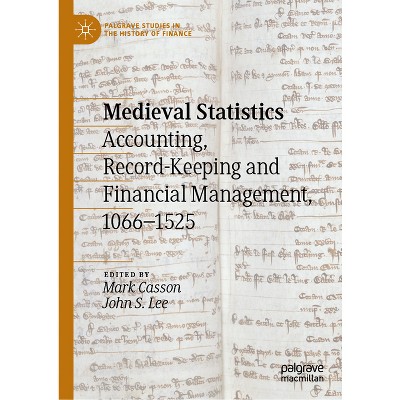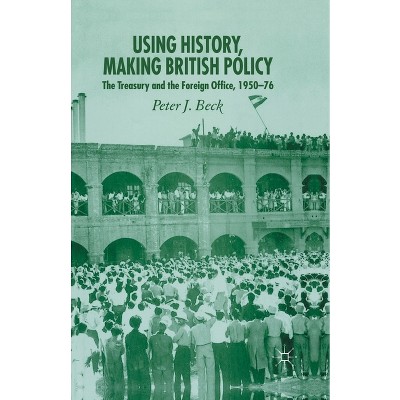British Imperialism and the Making of Colonial Currency Systems - (Palgrave Studies in the History of Finance) by Wadan Narsey (Hardcover)

$139.99 when purchased online
Target Online store #3991
About this item
Highlights
- Based on archival research covering more than two centuries and most former British colonies (West Indies, India, Singapore, Malaya, West Africa and East Africa), this book is a revisionist history of the British imperial manipulations of colonial currency systems to facilitate the rise of sterling to world supremacy via the gold standard, and to slow its eventual decline after World War II.
- About the Author: Wadan Narsey is a former Professor of Economics at The University of the South Pacific.
- 356 Pages
- Business + Money Management, Finance
- Series Name: Palgrave Studies in the History of Finance
Description
Book Synopsis
Based on archival research covering more than two centuries and most former British colonies (West Indies, India, Singapore, Malaya, West Africa and East Africa), this book is a revisionist history of the British imperial manipulations of colonial currency systems to facilitate the rise of sterling to world supremacy via the gold standard, and to slow its eventual decline after World War II. Britain forcibly replaced international currencies, including gold and sterling itself, by new localised silver currencies, backed by gold and sterling reserves in London, under the total control of the British Treasury and the powerful influence of the Bank of England. Ignoring colonial needs, imperial decision-makers continuously over-ruled colonial governments, commercial interest in colonies (British and local), Colonial Office and the Crown Agents, to support liquidity in the London Money Market, convertibility of sterling, export of British capital, and cheap readilyavailable finance for the British Government. Academia, including Keynes and institutions like the London School of Economics, are shown to have played supporting roles. This book is valuable reading for academics and students interested in theories of imperialism, colonial underdevelopment, money (national and international) and related topics such as currency areas and exchange rates. Its comprehensive index links monetary concepts to actual events in the British Empire, with pointers to new research areas. This account of the rise and fall of sterling as a world currency may have lessons for the future trajectories of the US dollar, Euro, Chinese renminbi and the Indian rupee.From the Back Cover
Based on archival research covering more than two centuries and most former British colonies (West Indies, India, Singapore, Malaya, West Africa and East Africa), this book is a revisionist history of the British imperial manipulations of colonial currency systems to facilitate the rise of sterling to world supremacy via the gold standard, and to slow its eventual decline after World War II. Britain forcibly replaced international currencies, including gold and sterling itself, by new localised silver currencies, backed by gold and sterling reserves in London, under the total control of the British Treasury and the powerful influence of the Bank of England. Ignoring colonial needs, imperial decision-makers continuously over-ruled colonial governments, commercial interest in colonies (British and local), Colonial Office and the Crown Agents, to support liquidity in the London Money Market, convertibility of sterling, export of British capital, and cheap readily availablefinance for the British Government. Academia, including Keynes and institutions like the London School of Economics, are shown to have played supporting roles. This book is valuable reading for academics and students interested in theories of imperialism, colonial underdevelopment, money (national and international) and related topics such as currency areas and exchange rates. Its comprehensive index links monetary concepts to actual events in the British Empire, with pointers to new research areas. This account of the rise and fall of sterling as a world currency may have lessons for the future trajectories of the US dollar, Euro, Chinese renminbi and the Indian rupee.Review Quotes
Narsey offers us an original and pioneering investigation of how the British state regulated gold, silver and paper as media of exchange, debt, and savings in colonies, from simple management of coinage to the emergence of the currency board, to become a critical part and the heart of the British Empire. Appearing in the fascinating story are privateers in the eighteenth-century West Indies with gold standards based on the slave economy and contraband from the Spanish main, Keynes's work on the currency of the Raj, and twentieth-century debates about the colonial money supply and economic development. The common theme is that the economic interests of metropolitan Britain were almost always given primacy in the administration of colonial money. The book is a valuable addition to the economic history of both the British empire and of globalization.'
- Professor Richard Drayton, Rhodes Professor of Imperial History, Kings College, London 'Based on extensive archival research, Professor Narsey shows that imperial priorities took precedence over native desires for economic development in dependent colonies throughout the history of the British Empire. This was an undesirable, but fully intended, consequence of imperial financial innovations in the British colonies, including the currency boards of Hong Kong and Singapore whose later success came only when British political control was lifted.'
- Professor Larry Neal, Professor Emeritus of Economics, University of Illinois at Urbana-Champaign 'This is an important contribution to the growing body of knowledge on the history of colonial currency systems.'
- Chibuike Uche, Senior Researcher, African Studies Centre, Leiden
About the Author
Wadan Narsey is a former Professor of Economics at The University of the South Pacific. He is currently an Adjunct Professor at The Cairns Institute, James Cook University, and at Swinburne University, Australia. He is a former Fiji parliamentarian, a commentator on the political economy of Fiji and the Pacific and a regular columnist for the Fiji Times. He has a personal website: NarseyOnFiji.Dimensions (Overall): 8.5 Inches (H) x 5.5 Inches (W) x .88 Inches (D)
Weight: 1.28 Pounds
Suggested Age: 22 Years and Up
Number of Pages: 356
Genre: Business + Money Management
Sub-Genre: Finance
Series Title: Palgrave Studies in the History of Finance
Publisher: Palgrave MacMillan
Theme: General
Format: Hardcover
Author: Wadan Narsey
Language: English
Street Date: April 8, 2016
TCIN: 1001556238
UPC: 9781137553171
Item Number (DPCI): 247-20-7516
Origin: Made in the USA or Imported
Shipping details
Estimated ship dimensions: 0.88 inches length x 5.5 inches width x 8.5 inches height
Estimated ship weight: 1.28 pounds
We regret that this item cannot be shipped to PO Boxes.
This item cannot be shipped to the following locations: American Samoa (see also separate entry under AS), Guam (see also separate entry under GU), Northern Mariana Islands, Puerto Rico (see also separate entry under PR), United States Minor Outlying Islands, Virgin Islands, U.S., APO/FPO
Return details
This item can be returned to any Target store or Target.com.
This item must be returned within 90 days of the date it was purchased in store, shipped, delivered by a Shipt shopper, or made ready for pickup.
See the return policy for complete information.
Trending Non-Fiction


$12.54
MSRP $22.00
Save $5 when you spend $25 on select books
4.7 out of 5 stars with 20 ratings

$10.84
MSRP $15.99
Save $5 when you spend $25 on select books
4.9 out of 5 stars with 12 ratings


$20.75 - $21.99
MSRP $21.99 - $32.50 Lower price on select items
Save $5 when you spend $25 on select books on select items
4.6 out of 5 stars with 9 ratings

$18.71
MSRP $34.99
Save $5 when you spend $25 on select books
5 out of 5 stars with 9 ratings





